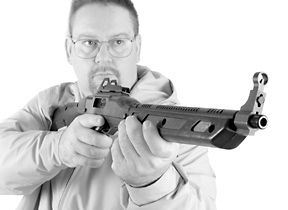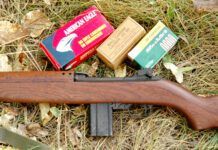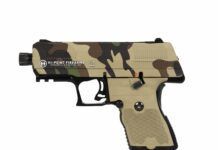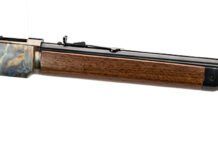
Without actually seeing the subjects of this month’s test, we imagined these two 9mm carbines as being a poor man’s AR-15, or perhaps an MP5. The two short rifles in question are in fact the $575 Ruger PC9, which operates from magazines common to Ruger’s P85-95 series pistols, and Hi-Point’s 9mm Carbine, $199. The Hi-Point cuts the figure of the type of machine pistol one envisions in the hands of SWAT or Special Forces. The Ruger, on the other hand, closely resembles a military rifle from the 1940s. Its profile is of a classic rifle punctuated by a long, narrow magazine hanging just ahead of the trigger guard.
But our test weapons were not specifically designed for military or police use. Instead, they are best used as plinking or self-defense pieces, in our estimation. Best traits: The PC9 and the Hi-Point are inexpensive to shoot — firepower to the people, as it were.
On the subject of price, the Hi-Point product is cheaper than nearly any pistol or revolver you can find — even less expensive than some of Hi-Point’s other firearms. In fact, the ultra-low price of the Hi-Point put us on guard. We have come to learn that in nearly every case, what you don’t pay for you don’t get. But there are rare exceptions, and the Hi-Point turned out to be one of them.
The price of the PC9 is, in our opinion, more in line with what one should expect to pay for a well-made firearm. At least subconsciously, we couldn’t help but expect more from the Ruger product, considering it cost more than twice what the Hi-Point did. Ultimately, however, we would have to base our recommendation solely on the evidence resulting from testing a single product sample, just like any other consumer would.
Range Session
We decided to visit a public range to test, and as a result, we had to deal with the interest and enthusiasm of the many owners who were getting in their first shots with the toys Santa had brought them. (Santa must have an FFL). We dare say both Hi-Point and Ruger may well see increased sales merely from our display of their wares. It seems people like carbines.
Accuracy data was collected from a bench rest at 50 yards. We actually used two different holds for our shots. One method was sandbag support underneath the forend with the butt held tightly against the shoulder, while the weak hand stabilized the buttstock. This is a common technique for rifles such as the AR-15 or, in this case the Hi-Point 995, where extra elevation from the bench is necessary due to its pistol grip design. In our second set, we supported the guns fore and aft with bench bags.
Instead of limiting ourselves to only three types of ammunition, we chose to fire four to see if we could find a round that caused jamming — a function fault that would kill these guns in our eyes. We fired full metal jacket ammunition from Winchester (115-grain roundnose) and the longer flat-nosed 147-grain Subsonic. Hollow points included 95-grain Starfire cartridges from PMC and Black Hills’s 115-grain +P. All tests were performed with the sights provided. We also fired the guns offhand to test the practical ergonomics of each carbine, shooting two-shot bursts (double-taps) as well as emptying the magazine. Here’s what we found:
Hi-Point 995 9mm Carbine, $199
Though each of our test rifles was chambered for 9mm Parabellum, operated on a blowback design fed by pistol-type magazines, and featured a composite stock, the Hi-Point 995 and the Ruger PC9 are separated by ergonomics. This results in at least one major operational difference. Holding the Ruger carbine, the shooter lays the cheek on the stock and sights down the bore in typical style. The Hi-Point 995, in contrast, promotes not a game hunting stance like the Ruger, but rather a man-hunting stance that is mobile. The sights are ghost ring types, and this allows for heads-up viewing. Using the pistol grip to pull the stock tightly into the pectoral area of the chest, with shoulders rolled forward, the model 995 adapts easily to contemporary entry team techniques where a narrow, compact profile is key. The overall appearance of the Hi-Point carbine is, in a word, foreboding. For those who think the cheap-looking plastic stock and forend topped with “ray-gun” cooling ribs over the barrel give it a toy-like appearance, well then this is one evil-looking toy.
Metal parts of the gun are, of course, the barrel and receiver and also the protective area around the front and rear sights. The sides of the buttstock flex, and they are accented by Allen bolts countersunk in place. The buttpad is integral with the stock, and although it does give a little, we can’t say it absorbs shock.
The grip, which houses the 10-round single-column magazine, is angled and contoured in a most natural manner. As would be typical for a pistol, the magazine release is on the left side just forward of the thumb, but most shooters will find it too far away to press without dismounting the rifle to some degree.
We found the magazine lips to be a little rough on our fingers when loading. Also, when shoving the mag into place, the natural tendency is to push it straight upward at a 90-degree angle to the bore. This won’t work. You have to remember that the grip is canted. This means presenting the magazine tipped forward parallel to the angle of the grip.
Just above the thumb on the left side is a simple safety lever, with down being the off-safe, ready-to-fire position. Chambering a round means working the bolt, which in this case means grasping a bolt handle with a hexagonal head that looks like it came from a hardware store. This piece isn’t installed in the box, but instead screws into the slide manually. A collar rides on the bolt, providing roller action. This collar also serves as a slide lock by fitting into a round cutout at the rear of its motion. It works by simply pulling back the slide and pressing it into place. This all sounds quite clumsy, and at times it is. But, if you remember to operate the bolt by letting your fingers slide off via the roller action, it is not so bad. Just watch for the edges of the hex bolt.
The trigger is ventilated to appear like the adjustable part commonly found on upscale 1911 pistols, but it just molded black plastic and operates on a hinge, not in a sliding manner. Despite its crude appearance, the trigger broke cleanly and without any complaint or grit.
We found this gun easy to hold, whether we were standing with the butt in the crook of our shoulder or in the SWAT stance described earlier. The Hi-Point 995 also adapted well to benchrest shooting. You probably noticed in our introduction we weren’t expecting much from this carbine, and all but said at such a low price (actual retail was $170) we’d be happy if it was limited to operation with a single brand of cartridge. But despite tests with a variety of ammunition, neither the Hi-Point nor the Ruger carbine gave us a moment of trouble. In fact, our Hi-Point consistently outshot the Ruger PC9. The 995 averaged group sizes ranging from 1.5 to 1.8 inches from our 50-yard bench rest. The smallest groups measured 1.1 and 1.0 inches with the Winchester 147-grain FMJ Subsonic and the Winchester 115-grain FMJ rounds, respectively. We have to credit this mainly to the sights. The ghost ring system on the Hi-Point proved superior to the notch and post mounted on the Ruger. We did not adjust the sights on either rifle to shoot groups, but we should mention that the rear sight on the Hi-Point is adjustable for windage and elevation, and the front sight is adjustable for elevation. As crude as they appear, the sights work just fine because the basic system is sound.
Another reason for the accuracy of the Hi-Point was the trigger, which was short and consistent without creep. This allowed the Hi-Point 995 to respond enthusiastically to rapid fire as well.
Ruger PC9 9mm Carbine, $575
The Ruger PC9 is similar in profile to a number of military weapons introduced shortly before World War II, particularly the Reising Model 50. The Reising M50 was first produced in 1938 by Eugene Reising and later manufactured by Harrington & Richardson. It was subsequently adopted by the United States Marines and used on Guadalcanal. Unfortunately, it ultimately proved unreliable and was taken out of service, according to David Miller in The Illustrated Dictionary of 20th Century Guns. Thankfully, the resemblance between the M50 and the Ruger PC9 is only cosmetic.
Our Ruger ran without a blip and cycled all manner of 9mm ammunition even more rapidly than the Hi-Point. This same configuration is available chambered for .40 S&W. Very similar models in the Ruger catalog also chamber .223 Remington and even 7.62X39 Russian, but we like the PC9 because maximum capacity gives it an edge. While 10+1 is the legal limit on new magazines, there are enough pre-ban 15-round mags to keep this rapid-firing rifle fat and on the go.
The PC9 is built upon a synthetic stock of black DuPont Zytel. The buttpad is rubber, and there is checkering at the forend and on the sides of the grip. The action is a blowback design, similar to the one found on the 10/22. The safety appears at the upper rear of the trigger guard, sliding right to left for fire. The double column magazine is held in an abbreviated well just ahead of the trigger guard. The protruding magazine should not be mistaken for a grip area.
Both the magazine release and slide lock are on the left side of the rifle. Sling swivels are provided fore and aft, as is a pistol type rear sight that is adjustable for both windage and elevation. The front blade is connected to the barrel by a roll pin and is protected by steel tabs. We pointed out earlier that the Ruger’s supplied notch and post sights made it difficult to execute a compact assault stance with the gun. But the PC9 could also be used in this manner with the addition of optics or taller sights, like those found on the 995. The gun did not come with Ruger’s integral scope rings, so mounting an optical scope would cost $65 more, plus the cost of the scope. (Two very good scopes for this model would be the Aimpoint 5000 2X red dot scope or Bushnell’s economical 1-4X32mm Banner Dusk and Dawn scope, $64.54 from Natchez Shooting Supply, [800] 251-7839. This latter unit features a circle for rapid acquisition of near targets and cross hairs for fine accuracy at a distance.) But any sight system that allows the shooter a heads up view would improve the defense capabilities of this Ruger.
In terms of the PC9’s accuracy, we weren’t necessarily disappointed with an overall average of 2.1 inches at 50 yards, but we expected the $575 gun to outshoot the $170 gun. The likely problem: the supplied sights. Trying to seat the top of the PC9’s narrow front sight blade repeatedly at the same point on a distant target proved difficult. Ghost rings just work better for this application, in our view. With optics in place, we think we could shoot the Ruger much more accurately than we did, probably as much as one full inch better.
But the gun also needs a more refined trigger to shoot its best. The PC9 displayed two take-ups. One was more or less a free movement, but another would appear with pressure, creating the expectation of the trigger breaking the shot. Once we decided to look at it as a two-stage trigger, our concentration improved. Of the two rifles, the Ruger seemed to recoil more. We could trace this to grip configuration. The Hi-Point offers more leverage to the body and the strong hand. Then again, the Ruger was producing about 75 fps more in average velocity from three out of the four cartridges over the Hi-Point, so maybe it wasn’t all stock design.
Gun Tests Recommends
Hi-Point 995 9mm Carbine, $199. Best Buy. Our sample performed much better in this test than in a previous evaluation (December 1997), showing an improved trigger, better accuracy, and flawless function. If all the Hi-Point carbines are as good as this one, then it’s a steal.
Ruger PC9, $575. Conditional Buy. The Ruger costs more than twice as much as the Hi-Point, and didn’t do as good a job as the cheaper gun in some important areas, such as accuracy or ease of use. But it did run without a hitch, and it should excel with improved sights. With a lot of pre-ban 15-round magazines still available, this weapon is a good home-defense option.





























I have owned a hi point 9mm carbine for 5+ years. After putting more than 5,000 rounds of various ammo through it with no jams, it is definitely my go to gun. I have since bought one each in .40 and .45. Even with all the smoke put out by reviewers initially about cheap price, plastic stock, and weight, I found none of this detrimental to the performance. Now throw in a life time parts and labor warranty and this is a real winner.
I have owned a hi point 9 mm carbine for 5+ years. After putting more than 5,000 rounds of various ammo through it with no jams, it is definitely my go-to gun. I have since bought one each in .40 and .45. Even with all the smoke put out by reviewers initially about cheap price, plastic stock, and weight, I found none of this detrimental to the performance. Now throw in a lifetime parts and labor warranty and this is a real winner.
retired u.s. army infantry officer. I am looking to purchase one for a disabled vet for home defense. all reviews and videos I have watched points to this a a go to carbine for his needs. planning to pay for one for him for his birthday and a Taurus G3 for Xmas. i am an advocate for finding quality firearms for thise on a budget. Hell…. I have 3 rock island armory 1911 compact 45 ACps and they shoot as good as my colts and a Kimber I had. Gifted the kimber ulra carry 45 to my oldest son a few years ago.
I have owned a High Point 9mm carbine for about 3 years. it is an outstanding carbine! One of the best buys for the $$ out there. Magazine only holds 10 rounds…that`s the only shortcoming.